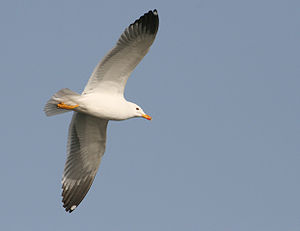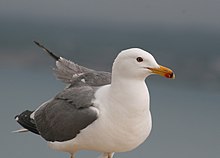Armenian Gull
| Armenian Gull | ||||||||||||
|---|---|---|---|---|---|---|---|---|---|---|---|---|

Armenian Gull in Armenia |
||||||||||||
| Systematics | ||||||||||||
|
||||||||||||
| Scientific name | ||||||||||||
| Larus armenicus | ||||||||||||
| Buturlin , 1934 |
The Armenian Gull ( Larus armenicus ) is a bird art within the gulls (Laridae). It is viewed by some authors as a subspecies of the Mediterranean gull with which it hybridizes locally . On the basis of studies of the mitochondrial DNA as well as of behavior and plumage characteristics, however, numerous other authors have granted it species status since the late 1990s. The breeding colonies of the Armenian gull are on mountain lakes in Asia Minor and in the Caucasus , where the species occurs in Armenia , Turkey , Iran and possibly Georgia . The wintering areas are in the east of the Mediterranean , in the far north of the Red Sea and perhaps also on the Persian Gulf .
description
With a body length of 52–60 cm and a wingspan of 120–140 cm, the Armenian gull belongs to the medium-sized Larus species. It is very similar to the closely related Mediterranean seagull, but overall somewhat smaller and darker on top. The eye is often darker and the beak, between 41 and 57 mm long, appears relatively short and blunt.
Adult dresses
Adult birds in breeding plumage have a dirty yellow to orange-yellow beak with a red gony spot and black markings in front of the tip of the beak, which can often (even in breeding plumage) be pronounced as a subterminal band. The tip of the beak is often a little lighter, so that the beak appears four-colored. In winter, the red gony spot is mostly covered by the black ring markings. The iris is quite variable. In the majority of birds it is dark or darkly spotted, a smaller percentage shows a light iris. In winter it is darker and only yellow in a few birds. The orbital ring is red. The legs are yellow in both breeding and winter plumage, tending towards green in winter, and often more orange-yellow in summer.
The head, chest and underside plumage is white in the breeding dress. In the winter dress the head is fine, the neck and sides of the chest are dashed a little stronger brown. The upper side is medium gray, the rear edge of the wing white and relatively wide on the arm wing. The hand wing shows a relatively compact, often triangular-looking, black tip that can reach down to the outer palm. A white subterminal field is usually only pronounced on the outer, tenth swing arm and the tips of the white swing arm are relatively narrow, so that they are almost completely worn away in summer. The tail is completely white.
Immature dresses
The youthful dress of the Armenian gull is similar to that of the Mediterranean gull, but is less dense underline and the dark dashed eye mask is less noticeable. The similarity also remains in the first winter dress, but the large arm covers in particular are reminiscent of the herring gull's first winter dress with their relatively even pattern. In addition, the inner hand wing shows a light field. In the second winter, gray feathers appear on the back, the body plumage looks lighter than in the first winter and the rump is already pure white. The umbrella feathers often have extensive white tips and hems and the beak brightens. In the third summer, the black on the wing tip is often even more extensive than on adult birds and some remnants of a dark tail band can still be seen. Birds in their fourth winter can no longer be distinguished from adults.
voice
The voice of the Armenian gull is described as shrill and hoarse and is less melodic than that of the herring gull . The " long call " sounds - as with the steppe gull - hectic and excited. The “albatross pose” typical of the steppe gull is missing.
Distribution and existence

The distribution area of the Armenian gull in Asia Minor and in the Caucasus extends over parts of the countries Armenia, Turkey and Iran, the species may also occur in Georgia. The total population is put at 23,000 to 25,000 breeding pairs. 98% of the population breed in four colonies. The largest with 11,000-13,000 pairs is located on Lake Sevan in Armenia. Another at the Arpilich Reservoir was previously important, but in 1999 it comprised only 15 breeding pairs - presumably due to disruptive activities and collection of eggs. In Turkey, the species occurs with 2000 breeding pairs on the island of Çarpanak Adası in Van Gölü (Lake Van), 500 pairs also breed on Tuz Gölü in Central Anatolia and 40–50 on Beyşehir Gölü . The Iranian population comprises around 4000–5000 pairs that only breed on one lake. The inventory trend was negative between 1930 and 1960, followed by a sharp increase and, locally, a sharp decline in recent times.
hikes
The Armenian gull is a partial migrant who probably follows the course of large rivers towards the coast and larger estuaries on the migration . The main wintering areas are in the eastern Mediterranean, where up to 60,000 specimens can be found in Israel from August. The high point of arrival is usually between October and December. The largest concentrations there consisted of 15,000-20,000 birds. The species also winters in smaller numbers in northern Egypt. Winter evidence is available from Sicily, the Black and Caspian Seas as well as the Gulf States ( Oman , United Arab Emirates , Bahrain ) and the northern Indian Ocean . Possible confusion with the subspecies L. f. barabensis of the black-backed gull make the evidence in the south and east of the Arabian Peninsula appear questionable.
habitat
The Armenian gull occurs outside of the breeding season on coasts and inland waters, but breeds exclusively on mountain lakes up to 1900 m altitude. The colonies are there in reeds, on stony or grassy bank areas or in agricultural areas.
Systematics
The Armenian gull was described in 1934 by Sergei Alexandrowitsch Buturlin as a subspecies of Larus taymirensis - a gull taxon, whose nominate form is considered today as a subspecies of the black-backed gull ( Larus fuscus ) or the "tundra gull" ( L. (f.) Heuglini ). In the course of the controversial discussions about a reorganization of the “white-headed seagulls” within the genus Larus , some authors took the view in the 1960s that armenicus should be given species rank. This was justified by, among others, Pierre Devillers with the unusual beak drawing. Even if this did meet with a consensus, specific investigations were only carried out in 1999 by Dorit Liebers and Andreas Helbig . These showed that in the main distribution area of armenicus a predominant percentage of all birds show a stable combination of characteristics, which clearly distinguish them from michahellis . In the west of the range, on the other hand, there are many birds of an intermediate type, which often cannot be clearly assigned due to the phenotype. This indicates a mixture of the two forms, which is supported by genetic findings. Mitochondrial haplotypes , which are typical for michahellis , are common in western Turkey, but no longer to be found in the east of the Anatolian highlands. This indicates, on the one hand, reproductive isolation , and, on the other hand, a gene flow from michahellis to armenicus . The Armenian gull is probably at a development stage between subspecies and biological species and forms the sister taxon of the Mediterranean gull . It is therefore to be assigned a corresponding rank in the taxonomy.
supporting documents
literature
- Klaus Malling Olsen, Hans Larsson: Gulls of Europe, Asia and North America , Helm Identification Guides, Christopher Helm, London 2003 (corrected new edition from 2004), ISBN 978-0-7136-7087-5
- Josep del Hoyo , Andrew Elliott, Jordi Sargatal (eds.): Handbook of the Birds of the World. Volume 3: Hoatzin to Auks. Lynx Edicions 1996, ISBN 978-84-87334-20-7 , pp. 610-611.
- Dorit Liebers: Phenotypical characterization and systematic position of the Armenian gull Larus armenicus , in this: Phylogeographical differentiation and relationships of great gulls of the Larus argentatus - fuscus - cachinnans group: Investigations using DNA sequences of the mitochondrial control region , inaugural dissertation at Ernst-Moritz-Arndt -Universität Greifswald, 2000, pp. 53–65
- JM Collinson, DT Parkin, AG Knox, G. Sangster, L. Svensson: Species boundaries in the Herring and Lesser Black-backed Gull complex . British Birds 101 (7), 2008, pp. 340-363.
- Dorit Liebers and Andreas J. Helbig : Phenotypical characterization and systematic position of the Armenian gull Larus armenicus , Limicola 13, 1999, pp. 281–321.
Web links
- First description by SA Buturlin, excerpt from Ibis ser. 13 (4): pp. 171-172
Single receipts
- ↑ a b c K. M. Olsen / H. Larsson (2003), p. 300, s. literature
- ↑ KM Olsen / H. Larsson (2003), p. 304, s. literature
- ↑ Liebers (2000), p. 55, p. literature
- ↑ a b c d e f K. M. Olsen / H. Larsson (2003), p. 301, s. literature
- ↑ Olson / Larsson (2003), pp. 300-307, s. literature
- ↑ a b Liebers (2000), p. 53, p. literature
- ↑ KM Olsen / H. Larsson (2003), p. 304, s. literature
- ↑ Del Hoyo et al., P. literature
- ^ SA Buturlin: Larus taimyrensis armenicus, subsp. nov. in Short notes [1934] Ibis ser. 13 (4): 171-172., P. Web links
- ↑ Jürgen Haffer : Systematics and taxonomy of the Larus argentatus species group in Urs N. Glutz von Blotzheim , KM Bauer: Handbuch der Vögel Mitteleuropas , Volume 8 / I, Charadriiformes (3rd part), Snipe, Gull and Alkenvögel, AULA- Publisher, ISBN 3-923527-00-4
- ↑ Liebers (2000), p. 64f and Collins (2008), p. 352, s. literature





